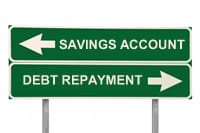 This is a question that I hear all the time:
This is a question that I hear all the time:
“Should I pay off my credit card debt or build an emergency savings account?”
The answer shouldn’t be one or the other – it should be both.
Let’s look at the numbers by using this example: Joe (a person I made up just now) has $5,000 in credit card debt with an interest rate of 14%. His minimum payment is about $100 a month. Joe’s monthly expenses are $4,000 (that includes everything – his mortgage, utilities, food, even his minimum credit card payment). Joe has reduced his expenses enough that he has about $400 left over each month that he can use to pay an additional amount on the credit card or to deposit into his savings. He’s committed to his cause, but he’s not sure what to do. He knows that carrying credit card debt is not a good thing, but neither is not having an emergency savings to fall back on in times of need.
Here are some choices Joe could make.
- Joe could pay $200/month towards his credit card debt. That will take him 30 months (2 1/2 years) to be debt free assuming that he stops charging.
- If he pays $250/month, he will be debt free in 23 months (2 years).
- If he pays $300/month, he will be debt free in 19 months (1 1/2 years).
None of these choices take up all of the $400, so there is still money for his emergency savings. He will be putting away $100 to $200/per month towards his emergency savings and that means he will have saved $1,200 to $2,400 (plus interest) at the end of each year.
The smart choice is to do both versus one or the other. Getting yourself out of debt should be one of your top financial goals, but not at the expense of your savings account. One emergency without a savings account will put you right back into debt.
Leave a Reply